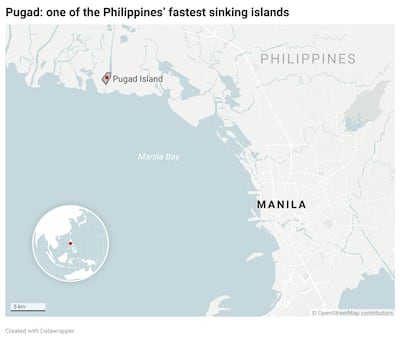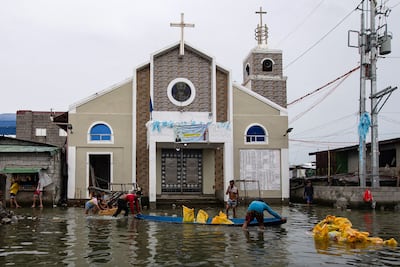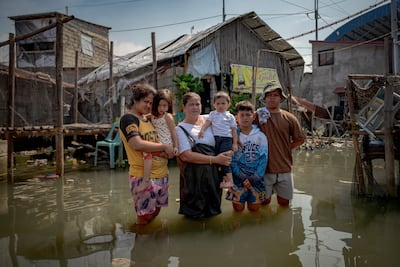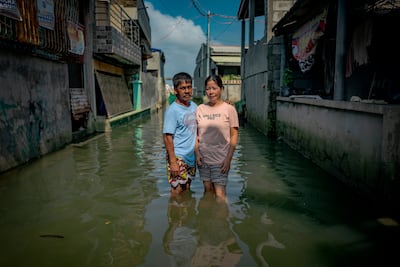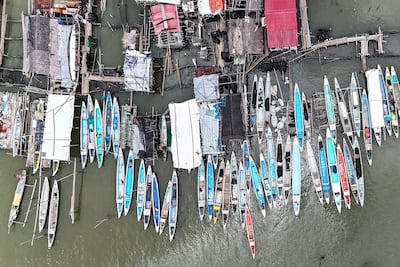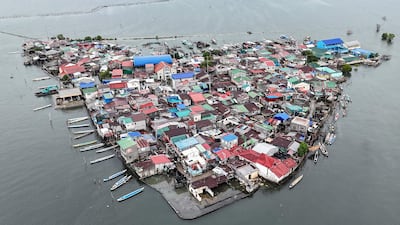On the Philippine island of Pugad, street food seller Maria Tamayo wakes before her grandchildren to begin the back-breaking work of bailing seawater from her home with a plastic dustpan.
The chore has been the same since the rising tides of Manila Bay began swallowing the island – a seven-hectare speck of land in danger of sinking completely.
The 65-year-old said she can spend up to three hours a day bailing water.
Mrs Tamayo is one of 2,500 people living in Pugad's only village.
The island is not the only one at risk in coastal Bulacan, the province directly north of Metro Manila.
Parts of the province are sinking at a rate of almost 11cm a year, the fastest in the Philippines, according to a study led by geologist Mahar Lagmay.
The gradual sinking, known as land subsidence, is an phenomenon caused by the over-extraction of groundwater. It is being exacerbated by rising sea levels due to climate change.
“The rates of subsidence [on Pugad Island] are quite high,” Mr Lagmay says. While studies specific to the tiny island were lacking, existing data on surrounding areas told the story clearly, he added.
Rolling with the tide
With high tides flooding the streets at least three times a week, the sea dictates the rhythm of daily life on Pugad.
School timetables are adjusted daily based on tide charts to prevent children from contracting flood-borne diseases.
Homes have been raised on stilts to keep floors dry, while small businesses use high tables to keep their wares above the murky water that can rise by 1.5 metres on the worst days.
Sea levels rise faster than global average
Sea levels across the Philippines are already rising three times faster than the global average of 3.6mm per year, and the Department of Environment and Natural Resources has said this could accelerate to 13mm annually.
“Sea-level rise is being experienced in many parts of the country,” said Karlo Queano, geosciences chief at DENR. He warned coastal areas could disappear without large-scale intervention.
While piecemeal efforts are in place in some areas – groundwater extraction has been banned in parts of Bulacan since 2004 – a broad national strategy has yet to take shape.
A government study on the path forward was not expected until 2028, Mr Queano said.
Climate change making life on Pugad 'impossible'
“I think it's already impossible for our lives in the village to go back to normal because of climate change,” said Pugad village captain Jaime Gregorio.
Mr Gregorio said roads were being raised every three years to keep the community viable, but leadership changes meant the implementation of long-term flood mitigation projects was inconsistent.
For Ms Tamayo, who has lived on the island all her life, the constant adjustment to the tide has drained what little savings her family had.
Since 2022, they have been elevating their house each year, adding more gravel and concrete to stay above water, so far spending about 200,000 pesos (Dh12,800).
“I love this island so much, this was where my mum and dad raised me … but sometimes, I think about leaving because of the high tide,” Ms Tamayo said.
Her husband Rodolfo, a boatman, insists their livelihood depends on staying.
“We can't go to [other places], we won't have jobs there. We will go hungry,” he said.
Mr Lagmay said land subsidence could be reversed with effective government policies governing the over-digging of wells.
But addressing the rise of sea levels was impossible without a concerted effort by the world's industrialised countries to reduce greenhouse gas emissions, he said.
A UN climate fund established in 2023 to help countries like the Philippines address damage caused by climate change, meanwhile, remains unimplemented.
“We are talking of climate justice here. We have very little contribution to climate change, but we are very affected by its adverse effects,” said Elenida Basug, the DENR's climate change service director.
Crouching in the doorway of her flooded home, Ms Tamayo urged the world's polluters to take responsibility for what she and her neighbours were experiencing.
“We are the ones who are suffering … They are rich, so we cannot do anything. Even if we speak against them, who would listen?” she said.
-With AFP
Company profile
Date started: 2015
Founder: John Tsioris and Ioanna Angelidaki
Based: Dubai
Sector: Online grocery delivery
Staff: 200
Funding: Undisclosed, but investors include the Jabbar Internet Group and Venture Friends
Important questions to consider
1. Where on the plane does my pet travel?
There are different types of travel available for pets:
- Manifest cargo
- Excess luggage in the hold
- Excess luggage in the cabin
Each option is safe. The feasibility of each option is based on the size and breed of your pet, the airline they are traveling on and country they are travelling to.
2. What is the difference between my pet traveling as manifest cargo or as excess luggage?
If traveling as manifest cargo, your pet is traveling in the front hold of the plane and can travel with or without you being on the same plane. The cost of your pets travel is based on volumetric weight, in other words, the size of their travel crate.
If traveling as excess luggage, your pet will be in the rear hold of the plane and must be traveling under the ticket of a human passenger. The cost of your pets travel is based on the actual (combined) weight of your pet in their crate.
3. What happens when my pet arrives in the country they are traveling to?
As soon as the flight arrives, your pet will be taken from the plane straight to the airport terminal.
If your pet is traveling as excess luggage, they will taken to the oversized luggage area in the arrival hall. Once you clear passport control, you will be able to collect them at the same time as your normal luggage. As you exit the airport via the ‘something to declare’ customs channel you will be asked to present your pets travel paperwork to the customs official and / or the vet on duty.
If your pet is traveling as manifest cargo, they will be taken to the Animal Reception Centre. There, their documentation will be reviewed by the staff of the ARC to ensure all is in order. At the same time, relevant customs formalities will be completed by staff based at the arriving airport.
4. How long does the travel paperwork and other travel preparations take?
This depends entirely on the location that your pet is traveling to. Your pet relocation compnay will provide you with an accurate timeline of how long the relevant preparations will take and at what point in the process the various steps must be taken.
In some cases they can get your pet ‘travel ready’ in a few days. In others it can be up to six months or more.
5. What vaccinations does my pet need to travel?
Regardless of where your pet is traveling, they will need certain vaccinations. The exact vaccinations they need are entirely dependent on the location they are traveling to. The one vaccination that is mandatory for every country your pet may travel to is a rabies vaccination.
Other vaccinations may also be necessary. These will be advised to you as relevant. In every situation, it is essential to keep your vaccinations current and to not miss a due date, even by one day. To do so could severely hinder your pets travel plans.
Source: Pawsome Pets UAE
New UK refugee system
- A new “core protection” for refugees moving from permanent to a more basic, temporary protection
- Shortened leave to remain - refugees will receive 30 months instead of five years
- A longer path to settlement with no indefinite settled status until a refugee has spent 20 years in Britain
- To encourage refugees to integrate the government will encourage them to out of the core protection route wherever possible.
- Under core protection there will be no automatic right to family reunion
- Refugees will have a reduced right to public funds
TO%20CATCH%20A%20KILLER
%3Cp%3E%3Cstrong%3EDirector%3A%20%3C%2Fstrong%3EDamian%20Szifron%3C%2Fp%3E%0A%3Cp%3E%3Cstrong%3EStars%3A%3C%2Fstrong%3E%20Shailene%20Woodley%2C%20Ben%20Mendelsohn%2C%20Ralph%20Ineson%3C%2Fp%3E%0A%3Cp%3E%3Cstrong%3ERating%3A%3C%2Fstrong%3E%202%2F5%3C%2Fp%3E%0A
GIANT REVIEW
Starring: Amir El-Masry, Pierce Brosnan
Director: Athale
Rating: 4/5
MATCH INFO
FA Cup fifth round
Chelsea v Manchester United, Monday, 11.30pm (UAE), BeIN Sports
Wicked: For Good
Director: Jon M Chu
Starring: Ariana Grande, Cynthia Erivo, Jonathan Bailey, Jeff Goldblum, Michelle Yeoh, Ethan Slater
Rating: 4/5
The Old Slave and the Mastiff
Patrick Chamoiseau
Translated from the French and Creole by Linda Coverdale
MATCH INFO
Euro 2020 qualifier
Ukraine 2 (Yaremchuk 06', Yarmolenko 27')
Portugal 1 (Ronaldo 72' pen)
Coffee: black death or elixir of life?
It is among the greatest health debates of our time; splashed across newspapers with contradicting headlines - is coffee good for you or not?
Depending on what you read, it is either a cancer-causing, sleep-depriving, stomach ulcer-inducing black death or the secret to long life, cutting the chance of stroke, diabetes and cancer.
The latest research - a study of 8,412 people across the UK who each underwent an MRI heart scan - is intended to put to bed (caffeine allowing) conflicting reports of the pros and cons of consumption.
The study, funded by the British Heart Foundation, contradicted previous findings that it stiffens arteries, putting pressure on the heart and increasing the likelihood of a heart attack or stroke, leading to warnings to cut down.
Numerous studies have recognised the benefits of coffee in cutting oral and esophageal cancer, the risk of a stroke and cirrhosis of the liver.
The benefits are often linked to biologically active compounds including caffeine, flavonoids, lignans, and other polyphenols, which benefit the body. These and othetr coffee compounds regulate genes involved in DNA repair, have anti-inflammatory properties and are associated with lower risk of insulin resistance, which is linked to type-2 diabetes.
But as doctors warn, too much of anything is inadvisable. The British Heart Foundation found the heaviest coffee drinkers in the study were most likely to be men who smoked and drank alcohol regularly.
Excessive amounts of coffee also unsettle the stomach causing or contributing to stomach ulcers. It also stains the teeth over time, hampers absorption of minerals and vitamins like zinc and iron.
It also raises blood pressure, which is largely problematic for people with existing conditions.
So the heaviest drinkers of the black stuff - some in the study had up to 25 cups per day - may want to rein it in.
Rory Reynolds
ASSASSIN'S%20CREED%20MIRAGE
%3Cp%3E%0DDeveloper%3A%20Ubisoft%20Bordeaux%0D%3Cbr%3EPublisher%3A%20Ubisoft%0D%3Cbr%3EConsoles%3A%20PlayStation%204%26amp%3B5%2C%20PC%20and%20Xbox%20Series%20S%26amp%3BX%0D%3Cbr%3ERating%3A%203.5%2F5%3C%2Fp%3E%0A
Lexus LX700h specs
Engine: 3.4-litre twin-turbo V6 plus supplementary electric motor
Power: 464hp at 5,200rpm
Torque: 790Nm from 2,000-3,600rpm
Transmission: 10-speed auto
Fuel consumption: 11.7L/100km
On sale: Now
Price: From Dh590,000
Kathryn Hawkes of House of Hawkes on being a good guest (because we’ve all had bad ones)
- Arrive with a thank you gift, or make sure you have one for your host by the time you leave.
- Offer to buy groceries, cook them a meal or take your hosts out for dinner.
- Help out around the house.
- Entertain yourself so that your hosts don’t feel that they constantly need to.
- Leave no trace of your stay – if you’ve borrowed a book, return it to where you found it.
- Offer to strip the bed before you go.
The%20specs
%3Cp%3E%3Cstrong%3EPowertrain%3A%20%3C%2Fstrong%3ESingle%20electric%20motor%0D%3Cbr%3E%3Cstrong%3EPower%3A%20%3C%2Fstrong%3E201hp%0D%3Cbr%3E%3Cstrong%3ETorque%3A%20%3C%2Fstrong%3E310Nm%0D%3Cbr%3E%3Cstrong%3ETransmission%3A%20%3C%2Fstrong%3ESingle-speed%20auto%0D%3Cbr%3E%3Cstrong%3EBattery%3A%20%3C%2Fstrong%3E53kWh%20lithium-ion%20battery%20pack%20(GS%20base%20model)%3B%2070kWh%20battery%20pack%20(GF)%0D%3Cbr%3E%3Cstrong%3ETouring%20range%3A%20%3C%2Fstrong%3E350km%20(GS)%3B%20480km%20(GF)%0D%3Cbr%3E%3Cstrong%3EPrice%3A%20%3C%2Fstrong%3EFrom%20Dh129%2C900%20(GS)%3B%20Dh149%2C000%20(GF)%0D%3Cbr%3E%3Cstrong%3EOn%20sale%3A%3C%2Fstrong%3E%20Now%3C%2Fp%3E%0A
UAE currency: the story behind the money in your pockets
Specs
Engine: 51.5kW electric motor
Range: 400km
Power: 134bhp
Torque: 175Nm
Price: From Dh98,800
Available: Now

